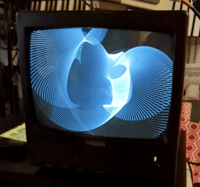11-04-23 Wobbulator Workshop Registration - Ithaca, NY
Led by Jen Kutler, each participant is asked to bring two working CRT televisions- one as the donor CRT and one as the CRT to be modified and become the wobbulator.
Tools and soldering irons will be provided. The cost of the workshop is between $100 and $175 per person depending on location and preregistration is necessary at jenkutler.com/workshops. Registration closes one week before the beginning of each scheduled workshop to ensure that we have enough materials and tools on hand. Due to the nature of high voltage electronics, each participant is required to sign a liability release form. Please direct all questions to [email protected].
Note: This workshop includes step-by-step guidance and construction of the actual Wobbulator. The participant is expected to bring their own (2) CRT monitors – one to use for parts and the other to modify. The donor CRT should be larger than the CRT to become the wobbulator. We have had the best results with wobbulator CRTs that are in the 5-9” range combined with donor CRTs in the 13-19” range. The workshop cost includes wire for winding the S coil, tools, and other miscellaneous parts, testing and troubleshooting. The workshop cost does not include or cover signal generators or oscillators (though generic parts are suitable and easy to come by). The focus of the workshop is on parts that are not commercially accessible. Oscillators and amplifiers will be available during the workshop to test modified CRTs. Since modifying CRTs is an experimental practice and every CRT is a bit different, there is no guarantee that every participant will leave the workshop with a working wobbulator.
If you really want to have a wobbulator for your project or studio and do not want to go through the process of building it yourself, reach out to me and I would be happy to discuss building one for you.
About the Wobbulator:
"A raster manipulation unit or 'wobbulator' is a prepared television which permits a wide variety of treatments to be performed on video images; this is accomplished by the addition of extra yokes to a conventional black and white receiver and by the application of signals derived from audio or function generators on the yokes. The unit is a receiver modified for monitor capability; all of the distortions can thus be performed either on broadcast signals or, when the unit is used as a monitor, on images from a live or prerecorded source. Although the image manipulations cannot be recorded directly, they can be recorded by using an optical interface. The patterns displayed on the unit are rescanned; a camera is pointed directly at the picture tube surface and scans the display. The video signal from this rescan camera is then input to a videotape recorder for immediate recording or to a processing system for further image treatment. The notion of prepared television has been investigated by a number of video artists and engineers; this particular set of modifications was popularized by Nam June Paik." - Excerpt from “Raster Manipulation Unit: Operation and Construction (1980)” from The Experimental Television Center by Sherry Hocking, Richard Brewster and Walter Wright.
You can learn more about Jen Kutler at jenkutler.com.
